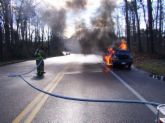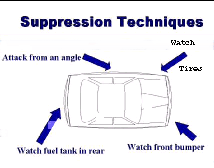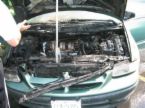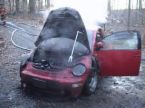| Cool the vehicle from a distance first. Use fog if needed as you move closer. |

 |
| The NFPA recommends that, as a minimum, the initial fire attack flow should be at least 125 GPM. This is a minimum. This amount should be easily provided by an 1-1/2" or 1-3/4" preconnected handline. |
| Cool the vehicle from a distance first. Use fog if needed as you move closer. |

 |
| If it is an engine or rear compartment fire, the first attack team should attack the fire 45 degrees at an angle toward the front or rear of the vehicle. Firefighters should not get themselves in a position in front of a 50 pound bumper that can explode outward around 200 feet. |
 |
| If the engine compartment is not opened or can not be opened, the attack team should attack the fire through a wheel well or hit the front of the car through the grill area with a straight stream pattern. This will knock the fire down until the car is opened up. |

 |
| When opening up the engine compartment, open it up from the side of the vehicle without getting yourself in front of the bumper and be cautious of exploding tires along with ruptured fuel tanks. |
| Remember after opening the hood or trunk of a vehicle, use an axe, pry bar, halligan tool, etc. to make sure the hood does not close on a firefighter during overhaul of the vehicle. |



 |
| If it happens to be an interior compartment fire, firefighters should work the fire from the side. If additional firefighters are on scene, they should take on the responsibility of opening up the car whether it is an engine or interior compartment fire. |  |
| The trunk of the vehicle should always be opened whether it is an engine compartment or interior compartment fire to look for any other issues, which may be of concern. |
| Completely overhaul the vehicle to make sure there are no hot spots left to ignite later. |
| Expect the unexpected |
|---|
 Alternative Fueled Vehicle Crashes. |
|---|
![]()
 |
 |
 |
 |
 To Kolb |
|---|